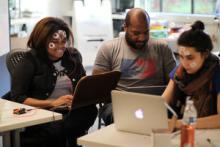Congratulations to philosophy graduate student Tim Brown, who was part of the winning team in this year’s Center for the Sensorimotor Neural Engineering (CSNE) 36-hour Hackathon. Fifteen students from the UW, San Diego State University, MIT and Spelman College competed in the Hackathon over a weekend in November. The goal was to design a solution to a neural engineering problem or to create a tool for educational outreach.
Every team was provided with a box of common supplies, including capacitors; open source software packets, or code that can be modified or enhanced by anyone; and wearable products that could be used to hold sensors. They were also free to use a 3-D printer. The Hackathon was open to both undergraduate and graduate students from the institutions partnered with the CSNE. Participants came from various majors ranging from electrical engineering to philosophy, and the teams were grouped so that each team member brought a specialty or a specific skill set.
Tim, who works with the CSNE on neuroethics, was a participant for the first time; last year he served as one of the judges. “I think staying open to the possibilities is what ethics gives you,” Brown said. “I’m more inclined to think of the different user populations affected by the technology that we’re building.”
The winning team included Tim Brown, Jaycee Holmes from Spelman College, and Catherine Yunis from MIT. Their project, Face the Music is an affordable, open-source way to play music using your face muscles. It can be used by patients with facial paralysis, for people learning about neuroscience, or anyone looking for a hands-free creative outlet. It uses a set of wet electrodes on the user’s face to pick up muscle activity in two places: on the cheeks and above the eyebrows. The signals are amplified and digitized using open-source devices worth a total of $100: a Backyard Brains Spiker Shield and an Arduino Uno. The signals are then analyzed and mapped to images and sounds.
The Hackathon was not all about competition, every team expressed support and enthusiasm for all the projects. “I admire the maker culture,” Brown said. “Everybody values open source and everyone values [the] sharing of information about schematics, and everybody here embodied that ideal.”
The event was co-sponsored by the virtual reality company Oculus Virtual Reality, CoMotion, and the Washington Research Foundation.
